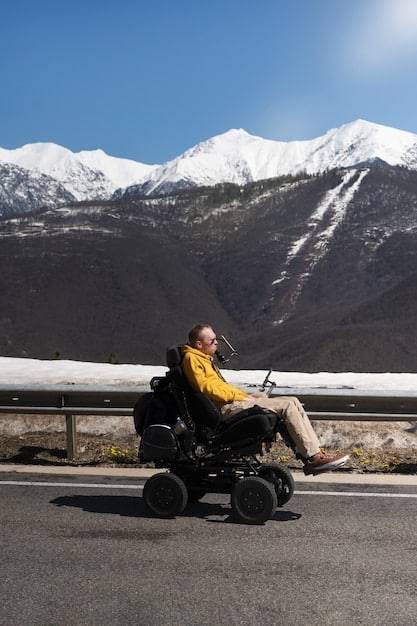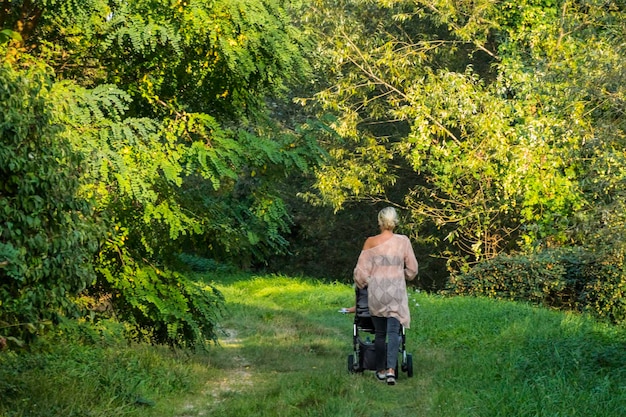The Complete Guide to Accessible Travel in the US: Resources & Destinations 2025

Navigating the complexities of accessible travel in the US for 2025 demands comprehensive knowledge of tailored resources and inclusive destinations to ensure seamless and enriching experiences for all travelers.
Embarking on a journey, whether for leisure or necessity, should be an experience accessible to everyone. In an evolving world, the travel industry is increasingly recognizing the diverse needs of all individuals. This comprehensive guide, focused on The Complete Guide to Accessible Travel in the US: Resources and Destinations for 2025, aims to illuminate pathways for
travelers with disabilities, offering insights, resources, and destination highlights to empower your adventures across the United States.
Understanding the Accessible Travel Landscape in the US
The concept of accessible travel extends beyond mere ramps and widened doorways; it encompasses a holistic approach to ensuring equal opportunities for exploration and enjoyment. As we look towards 2025, the US continues to make strides in enhancing infrastructure and services, though challenges certainly remain. Understanding the current landscape is crucial for planning successful journeys.
Key to this understanding is the Americans with Disabilities Act (ADA), which has been instrumental in shaping accessibility standards across various sectors, including transportation, public accommodations, and government services. While the ADA provides a robust legal framework, its implementation can vary, making research and preparation paramount for travelers. This ongoing evolution means that staying informed about the latest updates and best practices is vital.
Legal Framework and Consumer Rights
The ADA mandates that public accommodations and commercial facilities provide goods and services to people with disabilities on an equal basis with the rest of the public. This includes hotels, restaurants, retail stores, and transportation providers. However, specifics can differ, especially regarding older facilities or unique natural environments like national parks.
- Title II of the ADA: Governs state and local government services, including public transportation.
- Title III of the ADA: Covers public accommodations and commercial facilities, ensuring equal access.
- Air Carrier Access Act (ACAA): Specifically protects passengers with disabilities from discrimination by airlines.
Knowing your rights is the first step towards advocating for yourself. Organizations like the Department of Justice and the Department of Transportation offer extensive resources detailing these regulations. Travelers should always verify accessibility features directly with providers, as interpretations of the ADA can sometimes lead to inconsistencies in practical application.
Beyond legal requirements, many businesses and destinations are embracing accessibility not just out of compliance, but as a commitment to inclusivity. This shift fosters a more welcoming environment, recognizing that accessible travel contributes significantly to the tourism economy and enriches the lives of countless individuals. It encourages innovative solutions and a more empathetic approach to service delivery, enhancing the overall travel experience for everyone involved.
Essential Resources for Planning Your Trip in 2025
Planning an accessible trip requires meticulous attention to detail, and fortunately, a wealth of resources exists to assist travelers. From specialized travel agencies to online databases, leveraging these tools can significantly streamline the planning process and help mitigate unforeseen challenges. As we approach 2025, the digital landscape continues to offer increasingly sophisticated tools for accessible travel planning.
One of the most valuable resources is the array of travel blogs and forums dedicated specifically to accessible travel. These platforms often provide firsthand accounts, practical tips, and recommendations that go beyond official guidelines, offering real-world perspectives on destinations and services. Engaging with these communities can provide invaluable insights and support from experienced accessible travelers.
Online Platforms and Databases
Several websites and apps specialize in listing accessible accommodations, attractions, and transportation options. These platforms are invaluable for preliminary research, allowing travelers to filter results based on specific accessibility needs.
- Wheelchair Accessible Travel (WAT) Blogs: Many bloggers chronicle their travel experiences, offering detailed reviews of accessible features, challenges, and tips.
- AccessNow: A community-driven app that rates the accessibility of places worldwide, including many locations across the US.
- Sagetraveling.com: Offers comprehensive guides and resources for accessible travel, often featuring specific destination reviews.
Beyond specialized platforms, mainstream travel booking sites are also improving their accessibility filters, though it’s always advisable to double-check information directly with the property or service provider. The granularity of details provided on many of these sites can vary, so direct contact remains the most reliable method for confirming specific accessibility features, such as roll-in showers or specific bed heights, which are crucial for many travelers.
Specialized Travel Agencies and Tour Operators
For those who prefer expert assistance, accessible travel agencies and tour operators can be a game-changer. These specialists possess in-depth knowledge of accessible infrastructure, can arrange specialized equipment rentals, and handle complex logistics, ensuring a smoother journey.
These agencies often have established relationships with hotels, cruise lines, and transportation companies that are genuinely committed to accessible services. They can also offer personalized itineraries, considering not only physical accessibility but also sensory and cognitive needs, creating truly inclusive experiences. Their expertise can save considerable time and reduce stress, especially for first-time accessible travelers or those planning multi-destination trips.
They also stay abreast of changes in accessibility legislation and infrastructure, providing up-to-date information that independent travelers might miss. The peace of mind that comes with knowing every detail has been considered by a knowledgeable professional is invaluable, allowing travelers to focus on the joy of their journey rather than the logistics.
Transportation Considerations and Solutions
Accessible transportation is the backbone of any travel plan. The United States offers a variety of options, each with its own set of accessibility features and challenges. Understanding these distinctions is crucial for selecting the most suitable mode of transport for your journey in 2025.
Air travel, while regulated by the Air Carrier Access Act (ACAA), requires careful planning, especially regarding wheelchair assistance, seating arrangements, and medical equipment. It is essential to communicate your needs to the airline well in advance of your flight. This allows them to make the necessary arrangements and provide adequate assistance, ensuring a more comfortable and dignified experience.
Air Travel: Navigating Airports and Airlines
Flying with a disability involves several considerations, from airport accessibility to in-flight services. Airlines are required to provide assistance with boarding, deplaning, and transferring to and from seats. However, advance notification of your specific needs is always recommended.
- Booking Assistance: Clearly state your accessibility needs when booking and reconfirm closer to travel.
- Personal Wheelchairs: Understand airline policies on collapsing, storing, and handling personal mobility devices.
- Service Animals: Familiarize yourself with airline and destination regulations concerning emotional support and service animals.
Consider requesting pre-boarding to allow ample time to settle in and store any necessary equipment. Also, be aware of the airport’s specific layout and services, such as accessible restrooms and relief areas for service animals. Knowing these details can significantly reduce stress on travel day, making the airport experience more manageable and less daunting. Some airports offer dedicated accessibility lanes for security checks, which can expedite the process.
Ground Transportation: Trains, Buses, and Rental Vehicles
Once you arrive at your destination, accessible ground transportation becomes vital. The options range from public transit to specialized private services, each offering varying levels of accessibility.
Amtrak, the national passenger rail system, strives to offer accessible services on most routes and trains. However, it’s advisable to verify the accessibility of specific stations and trains when booking. For buses, many major city buses are equipped with ramps or lifts, but long-distance coaches might have more limited options.
For greater flexibility, accessible rental vans are available in many major cities across the US. Companies like Wheelchair Getaways or MobilityWorks often provide a range of adaptive vehicles. Booking these well in advance is essential, especially during peak travel seasons, as their availability can be limited. Always confirm the specific modifications of the vehicle to ensure it meets your needs.
Ride-sharing services like Uber and Lyft also offer accessible options in some areas, but coverage can be inconsistent. Always check the availability of accessible vehicles through their apps in your specific location. Taxis can sometimes be hailed, but it is often more reliable to pre-book an accessible cab if available in your destination city, ensuring appropriate vehicle type and assistance.
When planning road trips, consider the accessibility of rest stops and gas stations along your route. Many interstate highways have accessible facilities, but it’s wise to map out these stops beforehand. This proactive approach helps in avoiding unexpected accessibility issues, contributing to a smoother and more enjoyable journey, especially on longer drives, where comfort and convenience are paramount.
Top Accessible Destinations in the US for 2025
The United States boasts an array of destinations that are increasingly prioritizing accessibility, making them ideal choices for travelers with disabilities in 2025. These locations offer not only accessible infrastructure but also a commitment to inclusive experiences, ensuring that everyone can partake in their unique offerings.
From vibrant cities with extensive public transit to serene national parks with accessible trails, the diversity of accessible options is growing. The key is to research specific attractions and accommodations within these destinations, as accessibility can vary widely even within the same city or park. Focusing on these top-tier destinations can significantly enhance the quality and ease of your travel experience.

Urban Adventures: Accessible Cities
Many major US cities have made significant progress in enhancing their accessibility, offering a wealth of cultural, culinary, and entertainment experiences. These cities often feature diverse options for accessible public transport and attractions.
- New York City, NY: While challenging due to its age, NYC has numerous accessible attractions, Broadway shows, and a growing number of accessible subway stations and bus routes.
- San Francisco, CA: Known for its progressive policies, San Francisco offers accessible cable cars, trolleys, and many attractions, including Alcatraz and Fisherman’s Wharf.
- Washington D.C.: The nation’s capital is highly accessible, with most monuments, museums (Smithsonian institutions), and federal buildings offering excellent accessibility.
These cities are continuously investing in improving their infrastructure, from curb cuts to accessible pedestrian signals. When planning urban trips, consider using services like AccessibleGo or Wheelchair Accessible Travel blogs for specific recommendations on restaurants, hotels, and tourist sites that have proven accessible features. Always double-check accessibility details directly with the venues before visiting, as online information can sometimes be outdated or incomplete, ensuring no unexpected surprises upon arrival.
Nature’s Splendor: Accessible National Parks
For nature lovers, many US national parks offer stunning accessible trails, viewpoints, and facilities, allowing everyone to experience the country’s natural beauty. These parks are making an effort to ensure their iconic landscapes are navigable for all visitors.
Yellowstone National Park, for instance, provides accessible boardwalks around geysers and hot springs, making its unique geothermal features enjoyable for wheelchair users. The Grand Canyon’s South Rim offers several accessible viewpoints and rim trails, providing breathtaking vistas without significant barriers. Yosemite National Park also has accessible lodging, shuttle services, and paved trails leading to magnificent waterfalls.
When visiting national parks, always check the park’s official website for their specific accessibility guides. These guides often provide detailed information on trails, restrooms, parking, and interpretive programs. Some parks even offer specialized equipment like all-terrain wheelchairs for loan, allowing access to more rugged terrains. Early planning is crucial for national park visits, especially during peak seasons, to secure accessible lodging and arrange any necessary specialized assistance.
The beauty of these accessible natural spaces lies in their ability to offer profound, humbling experiences to everyone, fostering a deeper connection with the environment. They remind us that the grandeur of nature should be a universal right, not a privilege, and that thoughtful design can unlock unparalleled beauty for all. Exploring these natural wonders can be a truly transformative experience.
Accommodation and Dining: Ensuring Comfort and Inclusivity
Finding suitable accommodation and dining options is a critical aspect of accessible travel planning. Beyond just meeting minimum ADA requirements, many establishments are now going above and beyond to ensure genuine comfort and inclusivity for travelers with disabilities. As 2025 approaches, the emphasis on comprehensive accessibility is becoming more prevalent across the hospitality sector.
When selecting hotels, it’s not enough to simply book an “accessible room.” Travelers should probe deeper into the specifics, such as doorway widths, bathroom configurations (roll-in showers versus tub transfers), bed height, and the accessibility of common areas like pools, fitness centers, and breakfast areas. Directly calling the hotel and speaking with a manager or accessibility coordinator is often the most reliable way to confirm all necessary features.
Hotels and Lodging: Beyond the Basic
While ADA compliance is a baseline, a truly accessible hotel experience considers every detail for comfort and independence. Many hotel chains are investing in updated accessibility features.
- Specific Room Features: Inquire about details like grab bars, shower chairs, toilet height, and space for maneuvering mobility devices.
- Common Area Accessibility: Ensure lobbies, restaurants, swimming pools, and business centers are easily navigable.
- Emergency Preparedness: Ask about emergency procedures for guests with disabilities, including evacuation plans and visual/auditory alarms.
Beyond traditional hotels, consider extended-stay accommodations or vacation rentals (like those found on Airbnb or VRBO) that specifically market themselves as accessible. Always filter and check reviews for detailed accessibility notes, and never hesitate to contact the host directly with specific questions. Some independent properties, particularly boutique hotels or bed-and-breakfasts, may offer charming but limited accessibility, so clear communication is key.

Dining Experiences: From Casual to Fine Dining
Enjoying local cuisine is integral to any travel experience, and accessible dining options are increasingly available. Many restaurants are prioritizing physical accessibility and inclusive service practices.
When researching restaurants, look for information on accessible entrances, restroom facilities, and table spacing. Online reviews from accessible travel communities or dedicated accessibility apps often provide valuable insights into a restaurant’s true level of accessibility. Websites like Yelp or Google Maps also allow users to filter for “wheelchair accessible” venues, which is a good starting point.
For more specific dietary needs or requests (e.g., allergies, texture modifications), it’s always advisable to call the restaurant in advance. This not only ensures they can accommodate your needs but also allows them to prepare for your arrival, potentially making for a smoother and more enjoyable dining experience. Many higher-end restaurants are particularly adept at handling special requests with grace and discretion.
Beyond physical access, the attitude of staff plays a huge role in an inclusive dining experience. Look for establishments where staff are trained in disability awareness and are genuinely welcoming and helpful. A restaurant that prioritizes an inclusive atmosphere will often proactively address potential barriers and ensure all patrons feel comfortable and respected, enhancing the enjoyment of the meal, regardless of any specific needs.
Tips for a Seamless Accessible Travel Experience in 2025
Even with the best planning, travel can present unexpected challenges. For accessible travel, a proactive and flexible approach is key to ensuring a smooth and enjoyable journey. These practical tips, geared towards 2025, can help minimize stress and maximize enjoyment, empowering you to navigate the US with confidence.
One of the most important aspects is to always have a contingency plan. Despite thorough research, unforeseen circumstances can arise, such as an elevator being out of service or a ramp not meeting expectations. Having alternative routes or service providers in mind can prevent significant disruptions to your itinerary. This involves a degree of flexibility and a willingness to adapt as needed.
Pre-Trip Preparation and Communication
Thorough preparation and clear communication are perhaps the most vital components of successful accessible travel. The more information you provide in advance, the better equipped service providers will be to meet your needs.
- Detailed Itinerary: Share your itinerary with family or friends, including contact numbers for all accommodations and transportation.
- Medical Information: Carry current medical information, including medication lists and doctor’s contacts, in an easily accessible format.
- Communication with Providers: Confirm all accessibility arrangements (hotels, airlines, tour operators) 24-48 hours before arrival.
Consider creating a “travel toolkit” that includes spare parts for mobility devices, necessary medical supplies, and adaptors. Labeling all personal medical equipment clearly with your contact information is also a wise precaution. Ensure your mobile phone is fully charged and consider a portable charger, as it’s your primary tool for communication and navigation. Carrying important documents, like passports and insurance details, in a secure yet accessible place is also recommended to prevent loss or damage.
On-the-Go Strategies and Advocacy
While traveling, being prepared to advocate for your needs politely but firmly is crucial. Most service providers are willing to help, but they might not always be aware of the specific nuances of your requirements.
Always allow extra time for transitions between different modes of transport or when navigating new environments. Unexpected delays are common in travel, and having buffer time can prevent missed connections or rushed experiences. Be patient, but also assertive when necessary to ensure your needs are met. Document any issues you encounter, including dates, times, names of staff, and photographs if appropriate, as this information can be useful for follow-up or feedback.
Utilize technology on the go, such as GPS apps that can indicate accessible routes or real-time public transit information. Many destinations also offer visitor information centers that can provide up-to-date accessibility details or assistance. Don’t hesitate to ask for help when needed; local knowledge can often unlock solutions that are not readily apparent from online research. Engaging with local communities can also lead to discovering hidden accessible gems.
Lastly, remember to prioritize rest and well-being. Accessible travel, even with meticulous planning, can be physically and mentally demanding. Building in downtime and not over-scheduling your days can significantly enhance your overall travel experience, allowing you to truly enjoy the destinations you’ve worked so hard to reach. Enjoying the journey is as important as the destination.
| Key Point | Brief Description |
|---|---|
| 🌍 Comprehensive Research | Thoroughly research destinations, accommodations, and transportation for specific accessibility features. |
| 📞 Direct Communication | Always speak directly with providers to confirm accessibility details and specific needs. |
| 🗺️ Leverage Resources | Utilize specialized travel agencies, online databases, and community forums. |
| ✅ Advocate & Adapt | Be prepared to advocate for your rights and adapt plans as needed for a smooth journey. |
Frequently Asked Questions about Accessible Travel in the US
▼
Your rights are primarily protected by the Americans with Disabilities Act (ADA) and the Air Carrier Access Act (ACAA). The ADA mandates accessibility in public accommodations and transportation services at state and local levels, ensuring equal access. The ACAA specifically prohibits discrimination against passengers with disabilities by airlines. These laws provide a strong framework for ensuring inclusive travel experiences throughout the US.
▼
Beyond checking the “accessible” box online, directly contact the hotel to confirm specific features like roll-in showers, grab bars, and room dimensions. Utilize specialized accessible travel websites and user reviews for detailed insights. Consider hotels that pride themselves on comprehensive accessibility over just basic compliance. Vacation rentals with transparent accessibility information can also be a good option.
▼
Many US National Parks are making significant efforts to improve accessibility, offering accessible trails, viewpoints, and visitor centers. However, accessibility can vary widely between parks and even within a single park. Always check the park’s official website for their specific accessibility guides, which detail accessible features, services, and any available specialized equipment like all-terrain wheelchairs. Planning ahead is key.
▼
Major cities often have accessible public buses and a growing number of accessible subway/metro stations. For more flexibility, accessible rental vans are available through specialized companies. Ride-sharing services like Uber and Lyft offer accessible vehicle options in some regions, though availability can be inconsistent. Always book in advance or confirm availability using apps in your specific location for reliable transport.
▼
Using a specialized accessible travel agency can be highly beneficial, especially for complex itineraries or if you prefer expert assistance. These agencies have in-depth knowledge of accessible infrastructure, can handle logistics, and often have relationships with truly accessible providers. They can save considerable time and reduce stress, ensuring a smoother, more personalized, and genuinely inclusive journey tailored to your specific needs.
Conclusion
Accessible travel in the US for 2025 is not just a burgeoning trend; it’s a fundamental right and an ever-evolving reality. While navigating the landscape requires diligent research, proactive communication, and a willingness to advocate, the increasing commitment to inclusivity across the travel industry offers unprecedented opportunities for exploration. By leveraging the available resources, understanding your rights, and embracing a spirit of adventure, travelers with disabilities can uncover the vast beauty and diverse experiences the United States has to offer, making every journey not just possible, but truly memorable and enriching.





